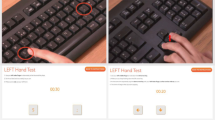Abstract
Among the clinical features of Parkinson’s disease, It’s important to evaluate Bradykinesia. In order to evaluate Bradykinesia, a Finger Tapping Test included in the kinematic test item on the Unified Parkinson’s Disease Rating Scale is employed. For the accuracy of evaluation, there is a need for a tool that can perform a Finger Tapping Test based on quantitative data. In this study, An AI based novel approach to evaluate a human motion function quantitatively was suggested and demonstrated for use of rehabilitation therapy using Mediapipe. For a preliminary experiment, the finger tapping test was employed to evaluate its clinical utilization. The developed software showed results that were very consistent with the expert’s evaluation opinion. The AI based developed software showed the high potential for clinical use as a quantitative evaluation tool that is cost-effective & easy to use.
Access provided by Autonomous University of Puebla. Download conference paper PDF
Similar content being viewed by others
Keywords
1 Background
Parkinson’s disease is a disease in which symptoms such as tremor, slow action, muscle stiffness, and postural imbalance occur because cells in the substantia nigra region of the brain that secrete the ‘dopamine’ hormone are unable to control hormone secretion due to damage to tissues or bodies caused by external forces or harmful effects. am [1].
The Parkinson’s Disease Rating Scale, which evaluates 4 areas (non-motor, exercise experience, motor test, and motor complications), is mainly used for understanding patients of Parkinson’s disease [2].
In order to evaluate Parkinson’s disease, there is a finger tapping test [3] in which the index and thumb are constantly opened and closed. Through this exercise area test, the speed and standard deviation of movement for each section can be calculated. However, up to now, occupational therapists qualitatively evaluate the exact position and movement speed of the fingers based on experience, with 0, 1, 2, 3, 4, and 5 points. These evaluation methods are not objective or quantitative, so there is a possibility that the reliability of the evaluation may be somewhat lowered.
In this study, we tried to develop software that can digitize these evaluation methods based on artificial intelligence and care for patients based on quantitative evaluation records.
2 Method
2.1 Program Design
The software were designed using MATLAB 2021b (Mathworks, USA). The appdesigner in matlab toolbox was employed to developed graphic user interface (GUI) software (Fig. 1).
2.2 Subjects
This study conducted an experiment on 30 normal adult men and women. Subjects selected those who agreed to participant based on a sufficient understanding of the study, and the purpose of this study was explained and conducted after obtaining consent. This study was approved by the Institutional Review Board (IRB) of Yonsei University (IRB: 1041849-202108-BM-133-01).
3 Results
3.1 Developed AI-Motion Software
The AI based motion analysis software (AI-Motion SW) was developed (see Fig. 2). The developed software comprised of 3 parts: 1) Motion capture using multi-webcam, 2) Motion estimation using AI (using mediapipe.com), 3) Quantitative Evaluation for behavior test.
3.2 Preliminary Human Study
The preliminary human test using finger test was conducted with 30 subjects. There is various significant difference that can depict high potential for clinical utilization. The following Table 1 show results which include 5 different motion features.
According to Table 1, there are 4 significant differences between young group and old group. These difference can describe the motion performance of human according to motion ability including position velocity, angle velocity, etc. more detail feature should be studied for enhancing the developed software.
References
Son, H.G., Park, H.J., Kim, S.J., Han, A.L.: The lived experience of health management in patients with Parkinson’s disease. J. Korean Acad. Soc. Nurs. Educ. 26(4), 423 (2020)
Austin, D., McNames, J., Klein, K., Jimison, H., Pavel, M.: A statistical characterization of the finger tapping test: modeling, estimation, and applications. IEEE J. Biomed. Health Inform. 19(2), 501–507 (2014)
Song, K.H., Lee, T.K., Kwak, J.H., Lim, H.S., Cho, H.Y., Kim, E.: Development of mobile based pre-screening app for Parkinson disease. The HCI Society of Korea, pp. 899–902 (2019)
Author information
Authors and Affiliations
Corresponding authors
Editor information
Editors and Affiliations
Rights and permissions
Copyright information
© 2022 Springer Nature Switzerland AG
About this paper
Cite this paper
Hwang, Sm., Park, S., Seo, Ny., Park, HY., Jung, YJ. (2022). AI Based Convenient Evaluation Software for Rehabilitation Therapy for Finger Tapping Test. In: Kim, JH., Singh, M., Khan, J., Tiwary, U.S., Sur, M., Singh, D. (eds) Intelligent Human Computer Interaction. IHCI 2021. Lecture Notes in Computer Science, vol 13184. Springer, Cham. https://doi.org/10.1007/978-3-030-98404-5_11
Download citation
DOI: https://doi.org/10.1007/978-3-030-98404-5_11
Published:
Publisher Name: Springer, Cham
Print ISBN: 978-3-030-98403-8
Online ISBN: 978-3-030-98404-5
eBook Packages: Computer ScienceComputer Science (R0)






